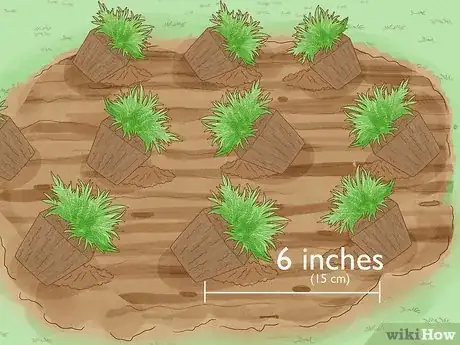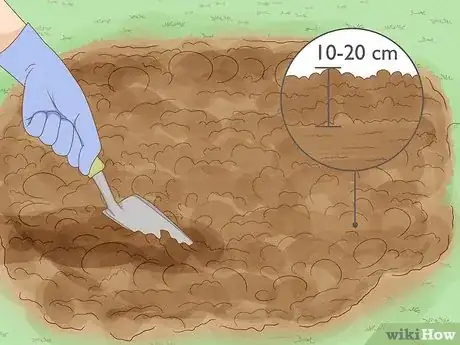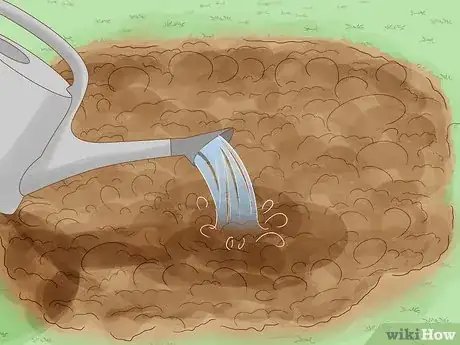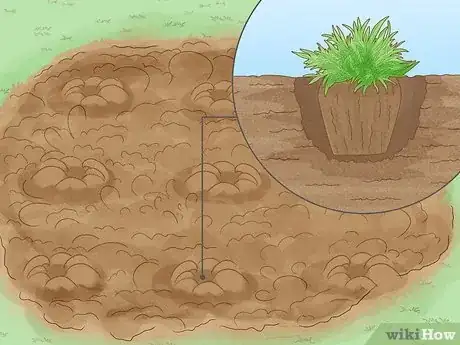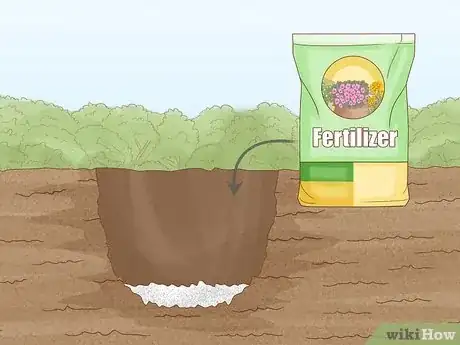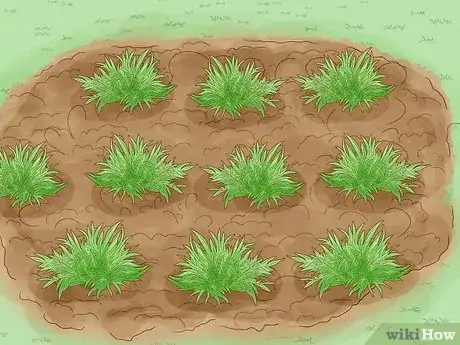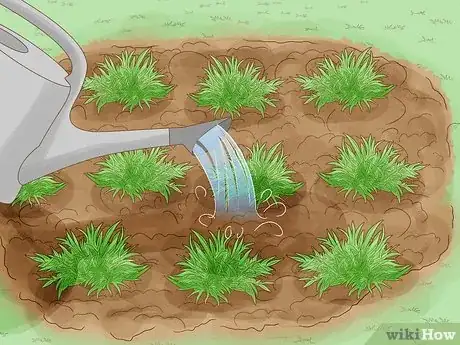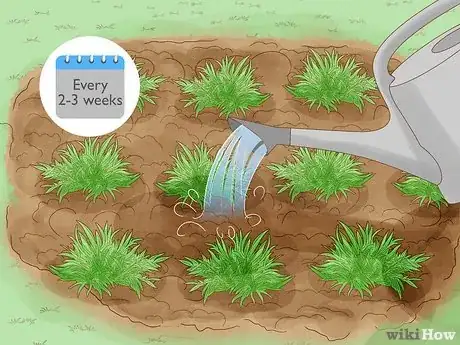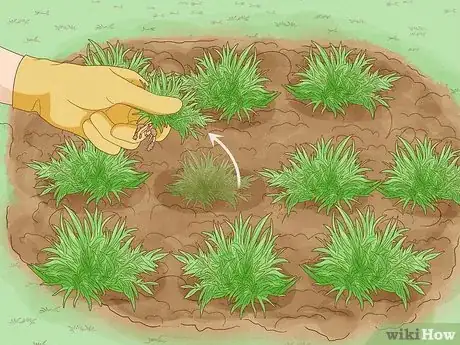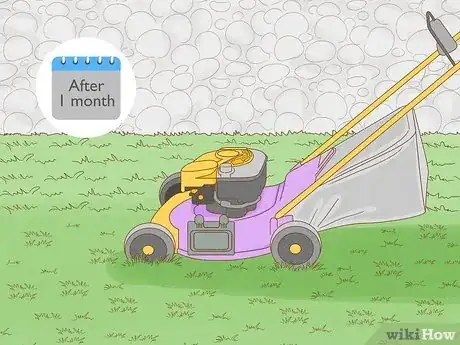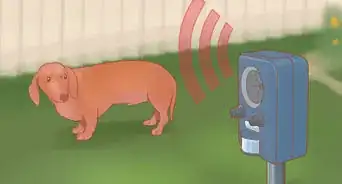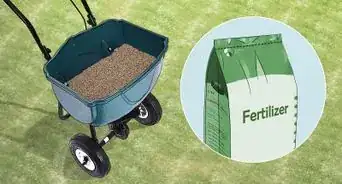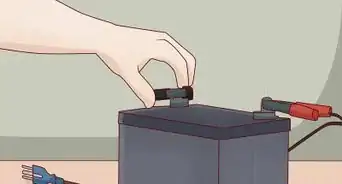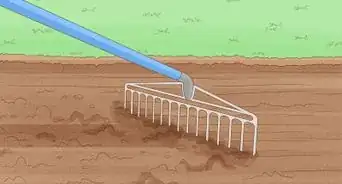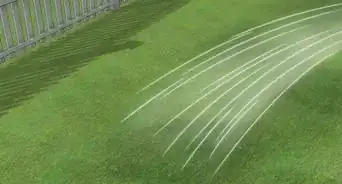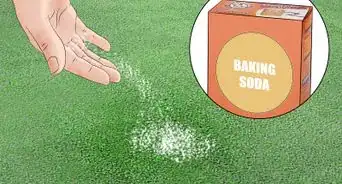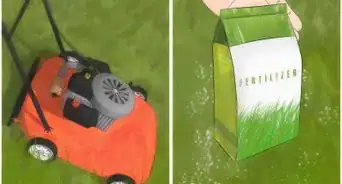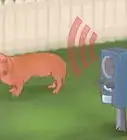This article was co-authored by Grant Wallace. Grant Wallace is a Landscaper and Owner of Grantlanta Lawn in Atlanta, Georgia. With over seven years of experience, he specializes in lawn maintenance and landscape installation. In 2012, he earned his BA from the University of West Georgia. Grant has been profiled in Shoutout Atlanta, Canvas Rebel, and Voyage ATL.
This article has been viewed 35,355 times.
Whether you're repairing patches in your yard or laying a new lawn, grass plugs are simple to grow. Before planting, however, you'll need to loosen and water the ground to create hospitable soil for grass plugs. You'll also want to water, fertilize, and weed the ground in the months after planting to help the grass plugs grow. With the proper care and maintenance, your grass plugs will thrive in their new environment.
Steps
Marking and Preparing the Soil
-
1Purchase fresh grass plugs for your yard. You can buy grass plugs from most garden centers or plant nurseries. While waiting to plant your grass plugs, water them daily to keep them moist and healthy.[1]
- Plant your grass plugs as soon as possible after buying them to help them thrive in their new environment.
- Buy approximately 1 plug per square foot (or 3 per square meter).[2]
-
2Space the grass plugs about 6 inches (15 cm) apart. Set each grass plug on the ground above where you want to plant them. Give each grass plug about 6 inches (15 cm) of space to prevent the plugs' root systems from overcrowding each other.[3]
- This will help you plan how many holes you'll need to dig and decide whether you'll need more grass plugs.
- Positioning the grass plugs in a diamond or checkerboard pattern is generally best for spacing.
Advertisement -
3Loosen the soil with a shovel or hoe. Using a shovel or hoe, hand-till the soil to a depth of about 10–20 centimetres (3.9–7.9 in). Repeat this process for the soil directly below each spot that you're planting a grass plug.[4]
- Loosening the soil helps the grass get nutrients from the ground more easily while the roots grow.
-
4Water the ground before planting the grass plugs. After loosening the soil, wet the ground with a hose or watering can. Stop watering when the soil looks damp—it should be moist, but not waterlogged.[5]
- Watering the soil helps further loosen the ground and create a hospitable environment for the grass plugs.
- Dipping the grass plugs in a container of water before planting them can also help the rots adapt to the soil.[6]
Placing Grass Plugs in the Soil
-
1Dig a hole about the same size as the grass plug's root ball. Measure the grass plug's root ball or eyeball its approximate length. Dip your shovel into the soil and dig a hole that's about the same depth and width as the root ball.[7]
- Avoid making the hole deeper than the root ball, as too deep can bury your grass plug's top.
-
2Place a fertilizer in the bottom of the hole. Sprinkle a grass or starter fertilizer into the hole as recommended by the package instructions, based on the hole's depth. Starter fertilizers help create a hospitable place for grass plugs as they develop root systems in the soil.[8]
- Buy a starter or grass plug fertilizer from a nearby garden center or plant nursery.
-
3Plant your grass plugs in the soil. Lower your grass plug into the hole and adjust it so the top stays upright. Fill the rest of the hole with soil, covering the entire root ball to prevent it from drying out later on.[9]
- Avoid covering the grass plug's top with soil, as this can increase the risk of diseases and fungal infections.
-
4Water the soil again after planting it. Once you've planted each grass plug into the soil, use your hose or watering can to water each one. Keep watering the soil until it is damp, but not waterlogged to prevent overwatering the plugs.[10]
Caring for Grass Plugs
-
1Water the grass plugs every day for 2-3 weeks. Giving the grass plugs plenty of water will help their root system adapt faster. Continue watering the plugs every day with the same technique that you used after planting them.[11]
- After 3 weeks have passed, water the grass plugs every other day from there onward.
-
2Weed the soil routinely as needed. Weeds can steal water and harmful nutrients from your grass plugs, particularly while they're still young. After watering your grass plugs, inspect the soil for weeds and pull any that you see as they grow.[12]
- Avoid using herbicides near the grass plugs, particularly during the first few months after planting.
-
3Fertilize your plugs once a month. Position the grass fertilizer's nozzle several inches or centimeters above the plugs and spray it and the surrounding soil. Continue fertilizing the plugs once monthly to give them additional nutrients while they grow.[13]
- You can buy grass fertilizers online or from most garden centers or nurseries.
- If you can't find a grass-specific fertilizer, choose a nitrogen-rich fertilizer with plenty of organic matter.
-
4Wait at least a month before mowing the lawn. After your grass plugs have established a root system, you can mow it as you would the rest of your lawn. But until a month has passed, mow around the newly-planted grass plugs.[14]
- Mowing new grass plugs can damage their root system and even kill them.
Warnings
- Although easy to plant, grass plugs are generally a pricier alternative to sod. If you want a cheaper way to plant grass, try laying sod in your yard instead.[16]⧼thumbs_response⧽
Things You'll Need
- Grass plugs
- Shovel
- Hose or watering can
- Starter fertilizer
- Grass fertilizer
- Hoe (optional)
Expert Interview

Thanks for reading our article! If you'd like to learn more about planting grass plugs, check out our in-depth interview with Grant Wallace.
References
- ↑ https://www.bhg.com/gardening/yard/lawn-care/start-a-lawn-with-plugs-sprigs/
- ↑ https://agreenhand.com/how-to-plant-grass-plugs/
- ↑ http://www.missouribotanicalgarden.org/gardens-gardening/your-garden/help-for-the-home-gardener/advice-tips-resources/gardening-help-faqs/questionid/135/afmid/4462.aspx
- ↑ https://www.youtube.com/watch?v=NROpKKxUHbw&feature=youtu.be&t=12
- ↑ https://www.bhg.com/gardening/yard/lawn-care/start-a-lawn-with-plugs-sprigs/
- ↑ http://www.missouribotanicalgarden.org/gardens-gardening/your-garden/help-for-the-home-gardener/advice-tips-resources/gardening-help-faqs/questionid/135/afmid/4462.aspx
- ↑ http://gardeningsolutions.ifas.ufl.edu/lawns/lawn-care/planting-your-florida-lawn.html
- ↑ http://gardeningsolutions.ifas.ufl.edu/lawns/lawn-care/planting-your-florida-lawn.html
- ↑ https://www.youtube.com/watch?v=NROpKKxUHbw&feature=youtu.be&t=56
- ↑ https://agreenhand.com/how-to-plant-grass-plugs/
- ↑ https://agreenhand.com/how-to-plant-grass-plugs/
- ↑ https://www.bhg.com/gardening/yard/lawn-care/start-a-lawn-with-plugs-sprigs/
- ↑ https://agreenhand.com/how-to-plant-grass-plugs/
- ↑ http://gardeningsolutions.ifas.ufl.edu/lawns/lawn-care/planting-your-florida-lawn.html
- ↑ http://gardeningsolutions.ifas.ufl.edu/lawns/lawn-care/planting-your-florida-lawn.html
- ↑ http://gardeningsolutions.ifas.ufl.edu/lawns/lawn-care/planting-your-florida-lawn.html

